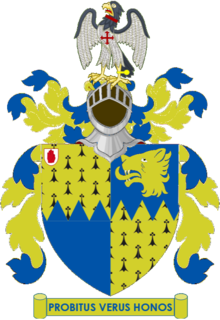The Lacon Baronetcy, of Great Yarmouth in the County of Norfolk, is a title in the Baronetage of the United Kingdom.[1] It was created on 11 December 1818 for Edmund Lacon. The second Baronet was High Sheriff of Norfolk. The third Baronet sat as Conservative Member of Parliament for Great Yarmouth and Norfolk North. The family seat has been Ormesby House in Ormesby St Michael.
Lacon baronets, of Great Yarmouth (1818)
[edit]- Sir Edmund Lacon, Kt., 1st Baronet (died 1826)[2]
- Sir Edmund Knowles Lacon, 2nd Baronet (1780–1839)[2]
- Sir Edmund Henry Knowles Lacon, 3rd Baronet (1807–1888)[2][3]
- Sir Edmund Broughton Knowles Lacon, 4th Baronet (1842–1899)[4]
- Sir Edmund Beecroft Heathcote Lacon, 5th Baronet (1878–1911)[5]
- Sir George Haworth Ussher Lacon, DSO, 6th Baronet (1881–1950)[6]
- Sir George Vere Francis Lacon, 7th Baronet (1909–1980)[7]
- Sir Edmund Vere Lacon, 8th Baronet (1936–2014)[8]
- Sir (Edmund) Richard Vere Lacon, 9th Baronet (born 1967)[9]
The heir apparent to the baronetcy is Luke Edmund Lacon (born 2001), only son of the 9th Baronet.[9]
Arms
[edit]
|
|
References
[edit]- ^ "No. 17404". The London Gazette. 3 October 1818. p. 1767.
- ^ a b c Foster, Joseph (1883). The Baronetage and Knightage of the British Empire. Westminster: Nichols and Sons. p. 368.
- ^ "Lacon, Edmund Henry Knowles (LCN823EH)". A Cambridge Alumni Database. University of Cambridge.
- ^ "Lacon, Sir Edmund Broughton Knowles". Who's Who. A & C Black. (Subscription or UK public library membership required.)
- ^ "Lacon, Sir Edmund Beecroft Francis Heathcote". Who's Who. A & C Black. (Subscription or UK public library membership required.)
- ^ "Lacon, Sir George Haworth Ussher". Who's Who. A & C Black. (Subscription or UK public library membership required.)
- ^ "Lacon, Sir George Vere Francis". Who's Who. A & C Black. (Subscription or UK public library membership required.)
- ^ "Lacon, Sir Edmund (Vere)". Who's Who. A & C Black. (Subscription or UK public library membership required.)
- ^ a b "Lacon, Sir (Edmund) Richard (Vere)". Who's Who. A & C Black. (Subscription or UK public library membership required.)
- ^ Burke's Peerage. 1914.
Well, that’s interesting to know that Psilotum nudum are known as whisk ferns. Psilotum nudum is the commoner species of the two. While the P. flaccidum is a rare species and is found in the tropical islands. Both the species are usually epiphytic in habit and grow upon tree ferns. These species may also be terrestrial and grow in humus or in the crevices of the rocks.
View the detailed Guide of Psilotum nudum: Detailed Study Of Psilotum Nudum (Whisk Fern), Classification, Anatomy, Reproduction